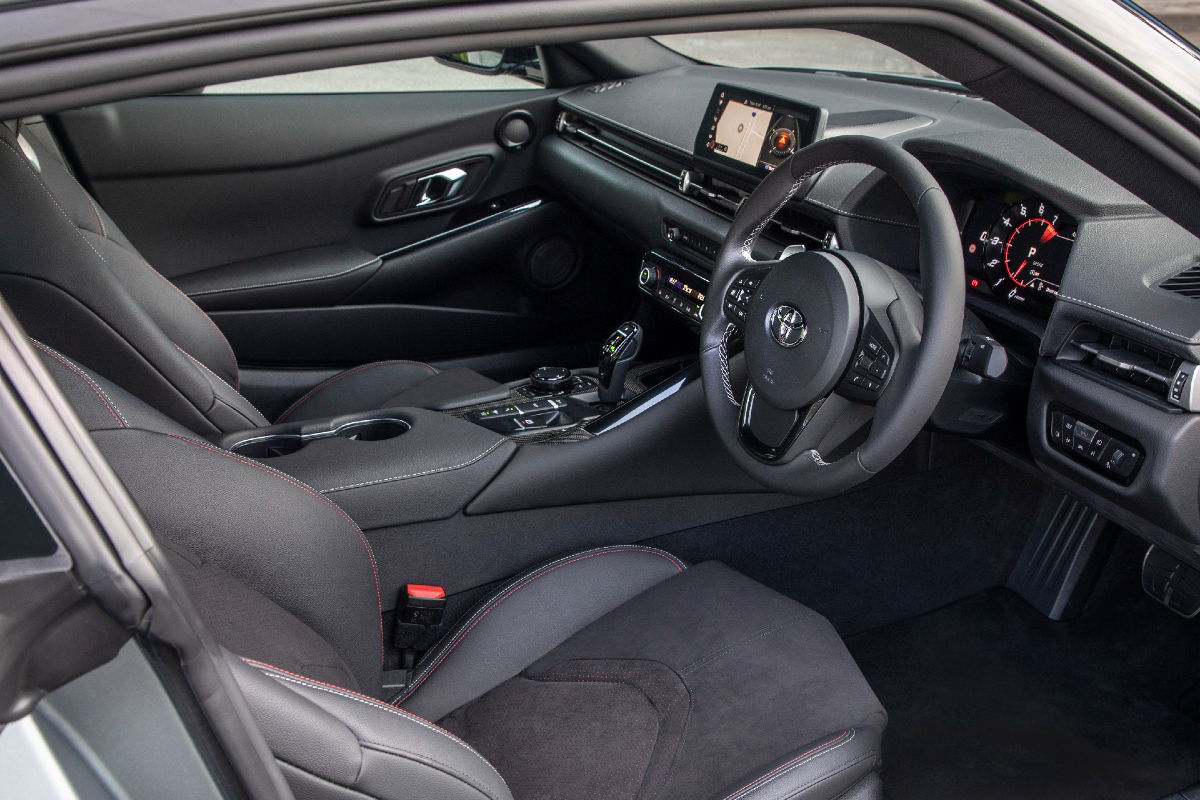
What is it?
A six-speed manual version of Toyota’s GR Supra straight-six sports car. A two-door, two-seat, rear-drive coupe, the Supra, while it’s been out a few years now, revives the Japanese brand’s famous sports car dynasty dating back to 1978.
The manual transmission itself, codenamed S6-53, is manufactured by ZF and goes back to the 2000s, used in various guises in many BMWs.
The manual Supra is 18kg lighter than the automatic, making this the lightest version you can get (at 1503kg kerb). That said, it uses quite a lot more fuel than the automatic – 8.9L/100km on the combined cycle (ADR81/02) versus 7.5L/100km for the eight-speed auto – and it’s also slower, Toyota claiming 0-100km/h in 4.1 seconds for the auto and 4.4 seconds for the manual. Maybe don’t tell your mates that bit.
Of course, BMW was and continues to be heavily involved with the engineering of the Toyota GR Supra – as in, it’s effectively a BMW underneath. Renowned for its rear-drive, straight-six vehicles, we could certainly think of worse brands to partner with. The Supra is made in Austria.
READ MORE: 2020 Toyota GR Supra GTS (auto) review
Does it have any racing pedigree?

Toyota’s motorsport history includes storied stints in the World Rally Championship, Le Mans, Formula One, NASCAR and IndyCar. It’s more a question of what it hasn’t had a crack at over the years (never Supercars, sadly, despite some flirtations). Those who played Gran Turismo as a kid will fondly recall a Supra racer in TOMS Castrol livery, while a Supra even raced at Bathurst in 1989, 1990 and 1991.
What’s under the bonnet?

Much like the previous JZA80 Supra of the nineties, the new one uses a 3.0-litre twin-turbocharged inline-six. That’s even if it’s not designed by Toyota, but BMW certainly knows its way around a straight-six. Codenamed B58 in BMW’s world, the Supra’s six-pot produces 285kW from 5800-6500rpm and 500Nm from 1800-5000rpm.
TRACK TEST: Toyota GR86 review
How does it handle?

The Supra handles exceptionally well, with sharp steering, tonnes of mid-corner grip and decent compliance over bumps. That’s even if there’s something ultimately a bit knife-edge about its handling, like if you were hammering through a corner with it all loaded up, and hit a bump with too much throttle on and maybe the ESC off, it could spit you into the trees in an instant. This is a vehicle you think twice about turning off the electronics, and not only because they’re very well calibrated, leaving you mostly alone.
The manual itself comes with switchable rev-matching software, so you can familiarise yourself with the chassis before adding an extra layer of difficulty by way of heel-toe down-changes – which we like.
Where would you most like to drive it?
The Haunted Hills hillclimb circuit in Victoria. Heaven is a place on earth, and that place is the driver’s seat of a manual GR Supra, enjoying loads of turbocharged torque, rear-drive and a mechanical limited slip diff. Haunted Hills has plenty of second-gear corners to play in, even if the walls are a bit close.
What’s the interior like?
It’s very classic sports car – you sit low and ensconced in the Supra, peering out of a low windscreen. The interior itself is nice enough, effectively a BMW cabin which means it’s very well built. There’s an 8.8-inch digital instrument display and an 8.8-inch infotainment touchscreen running BMW OS and wireless Apple CarPlay (wired Android Auto). The GTS adds head-up display and a better, 12-speaker stereo.
The Supra is only a two-seater and has some minor quirks, such as the lack of exterior boot release button. And Toyota has carried over all the various interior warning chimes and tones from BMW – surely they could have done their own?
The Supra’s manual shift action feels pretty solid, without being too heavy or clunky. While it doesn’t match the sublime, light, oily feeling of say a Honda manual, we do love the Supra’s manual shift-knob itself – a little leather ball that fits nicely in the hand. Weighing 200 grams, you can tell Toyota put a bit of thought into it.
How much does the Toyota Supra manual cost?
The base GT manual is $95,494 drive-away and the higher spec GTS manual, $106,015 drive-away. The manual and auto Supra cost the same.
Would I buy one?

Yes. Having a manual gearbox instead of an auto certainly makes for a more involving, engrossing driving experience. Relatively speaking, it’s also not bad value. The car that it is somewhat similar to – the BMW M2 – has left the planet from a pricing perspective, now starting from $121,700 before on-roads. If you’re happy to cop the lower power and less technology, the GR Supra offers much the same experience for a good twenty grand less. And it won’t be for too much longer you can buy a petrol-powered, rear-drive, manual sports car. What are you waiting for?















Discussion about this post